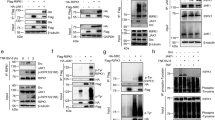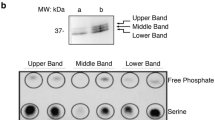Abstract
The proinflammatory cytokine tumor necrosis factor (TNF) modulates cellular responses through the mitogen-activated protein kinase (MAPK) and nuclear factor-κB (NF-κB) signaling pathways, but the molecular mechanisms underlying MAPK activation are unknown. T cell protein tyrosine phosphatase (TCPTP) is essential for hematopoietic development and negatively regulates inflammatory responses. Using TCPTP-deficient fibroblasts, we show here that TCPTP regulates TNF-induced MAPK but not NF-κB signaling. TCPTP interacted with the adaptor protein TRAF2, and dephosphorylated and inactivated Src tyrosine kinases to suppress downstream signaling through extracellular signal–regulated kinases and production of interleukin 6. These results link TCPTP and Src tyrosine kinases to the selective regulation of TNF-induced MAPK signaling and identify a previously unknown mechanism for modulating inflammatory responses mediated by TNF.
This is a preview of subscription content, access via your institution
Access options
Subscribe to this journal
Receive 12 print issues and online access
$209.00 per year
only $17.42 per issue
Buy this article
- Purchase on Springer Link
- Instant access to full article PDF
Prices may be subject to local taxes which are calculated during checkout







Similar content being viewed by others
References
Baud, V. & Karin, M. Signal transduction by tumor necrosis factor and its relatives. Trends Cell Biol. 11, 372–377 (2001).
Kyriakis, J.M. Life-or-death decisions. Nature 414, 265–266 (2001).
Chang, L. & Karin, M. Mammalian MAP kinase signalling cascades. Nature 410, 37–40 (2001).
Devin, A., Lin, Y. & Liu, Z.G. The role of the death-domain kinase RIP in tumour-necrosis-factor-induced activation of mitogen-activated protein kinases. EMBO Rep. 4, 623–627 (2003).
Chadee, D.N., Yuasa, T. & Kyriakis, J.M. Direct activation of mitogen-activated protein kinase kinase kinase MEKK1 by the Ste20p homologue GCK and the adapter protein TRAF2. Mol. Cell. Biol. 22, 737–749 (2002).
Ibarra-Sanchez, M. et al. The T-cell protein tyrosine phosphatase. Semin. Immunol. 12, 379–386 (2000).
Tiganis, T., Bennett, A.M., Ravichandran, K.S. & Tonks, N.K. Epidermal growth factor receptor and the adaptor protein p52Shc are specific substrates of T-cell protein tyrosine phosphatase. Mol. Cell. Biol. 18, 1622–1634 (1998).
Galic, S. et al. Regulation of insulin receptor signaling by the protein tyrosine phosphatase TCPTP. Mol. Cell. Biol. 23, 2096–2108 (2003).
Simoncic, P.D., Lee-Loy, A., Barber, D.L., Tremblay, M.L. & McGlade, C.J. The T-cell protein tyrosine phosphatase is a negative regulator of janus family kinases 1 and 3. Curr. Biol. 12, 446–453 (2002).
ten Hoeve, J. et al. Identification of a nuclear Stat1 protein tyrosine phosphatase. Mol. Cell. Biol. 22, 5662–5668 (2002).
Ibarra-Sanchez, M.J., Wagner, J., Ong, M.T., Lampron, C. & Tremblay, M.L. Murine embryonic fibroblasts lacking TC-PTP display delayed G1 phase through defective NFκB activation. Oncogene 20, 4728–4739 (2001).
Tiganis, T., Kemp, B.E. & Tonks, N.K. The protein tyrosine phosphatase TCPTP regulates epidermal growth factor receptor-mediated and phosphatidylinositol 3-kinase-dependent signalling. J. Biol. Chem. 274, 27768–27775 (1999).
Galic, S. et al. Coordinated regulation of insulin signaling by the protein tyrosine phosphatases PTP1B and TCPTP. Mol. Cell. Biol. 25, 819–829 (2005).
You-Ten, K.E. et al. Impaired bone marrow microenvironment and immune function in T-cell protein tyrosine phosphatase-deficient mice. J. Exp. Med. 186, 683–693 (1997).
Heinonen, K.M. et al. T-cell protein tyrosine phosphatase deletion results in progressive systemic inflammatory disease. Blood 103, 3457–3464 (2004).
Rosette, C. & Karin, M. Ultraviolet light and osmotic stress: activation of the JNK cascade through multiple growth factor and cytokine receptors. Science 274, 1194–1197 (1996).
Tobin, D., van Hogerlinden, M. & Toftgard, R. UVB-induced association of tumor necrosis factor (TNF) receptor 1/TNF receptor-associated factor-2 mediates activation of Rel proteins. Proc. Natl. Acad. Sci. USA 95, 565–569 (1998).
Mattila, E. et al. Negative regulation of EGFR signalling through integrin-α1β1-mediated activation of protein tyrosine phosphatase TCPTP. Nat. Cell Biol. 7, 78–85 (2005).
Flint, A.J., Tiganis, T., Barford, D. & Tonks, N.K. Development of 'substrate-trapping' mutants to identify physiological substrates of protein tyrosine phosphatases. Proc. Natl. Acad. Sci. USA 94, 1680–1685 (1997).
Elchebly, M. et al. Increased insulin sensitivity and obesity resistance in mice lacking the protein tyrosine phosphatase-1B gene. Science 283, 1544–1548 (1999).
Zabolotny, J.M. et al. PTP1B regulates leptin signal transduction in vivo. Dev. Cell 2, 489–495 (2002).
Myers, M.P. et al. TYK2 and JAK2 are substrates of protein-tyrosine phosphatase 1B. J. Biol. Chem. 276, 47771–47774 (2001).
Frangioni, J.V., Beahm, P.H., Shifrin, V., Jost, C.A. & Neel, B.G. The nontransmembrane tyrosine phosphatase PTP-1B localizes to the endoplasmic reticulum via its 35 amino acid C-terminal sequence. Cell 68, 545–560 (1992).
Lam, M.H. et al. Cellular stress regulates the nucleocytoplasmic distribution of the protein tyrosine phosphatase TCPTP. J. Biol. Chem. 276, 37700–37707 (2001).
Naka, T., Nishimoto, N. & Kishimoto, T. The paradigm of IL6: from basic science to medicine. Arthritis Res. 4 (Suppl. 3), S233–S242 (2002).
You, M., Flick, L.M., Yu, D. & Feng, G.S. Modulation of the nuclear factor κB pathway by Shp-2 tyrosine phosphatase in mediating the induction of interleukin (IL)-6 by IL-1 or tumor necrosis factor. J. Exp. Med. 193, 101–110 (2001).
Wysk, M., Yang, D.D., Lu, H.T., Flavell, R.A. & Davis, R.J. Requirement of mitogen-activated protein kinase kinase 3 (MKK3) for tumor necrosis factor-induced cytokine expression. Proc. Natl. Acad. Sci. USA 96, 3763–3768 (1999).
Yeatman, T.J. A renaissance for SRC. Nat. Rev. Cancer 4, 470–480 (2004).
Taylor, S.J., Anafi, M., Pawson, T. & Shalloway, D. Functional interaction between c-Src and its mitotic target, Sam 68. J. Biol. Chem. 270, 10120–10124 (1995).
Bivona, T.G. et al. Phospholipase Cγ activates Ras on the Golgi apparatus by means of RasGRP1. Nature 424, 694–698 (2003).
Silva, C.M. Role of STATs as downstream signal transducers in Src family kinase-mediated tumorigenesis. Oncogene 23, 8017–8023 (2004).
Ponniah, S., Wang, D.Z., Lim, K.L. & Pallen, C.J. Targeted disruption of the tyrosine phosphatase PTPα leads to constitutive downregulation of the kinases Src and Fyn. Curr. Biol. 9, 535–538 (1999).
Gil-Henn, H. & Elson, A. Tyrosine phosphatase-ε activates Src and supports the transformed phenotype of Neu-induced mammary tumor cells. J. Biol. Chem. 278, 15579–15586 (2003).
Hermiston, M.L., Xu, Z., Majeti, R. & Weiss, A. Reciprocal regulation of lymphocyte activation by tyrosine kinases and phosphatases. J. Clin. Invest. 109, 9–14 (2002).
Zhang, S.Q. et al. Shp2 regulates SRC family kinase activity and Ras/Erk activation by controlling Csk recruitment. Mol. Cell 13, 341–355 (2004).
Lorenz, U., Ravichandran, K.S., Burakoff, S.J. & Neel, B.G. Lack of SHPTP1 results in src-family kinase hyperactivation and thymocyte hyperresponsiveness. Proc. Natl. Acad. Sci. USA 93, 9624–9629 (1996).
Bjorge, J.D., Pang, A. & Fujita, D.J. Identification of protein-tyrosine phosphatase 1B as the major tyrosine phosphatase activity capable of dephosphorylating and activating c-Src in several human breast cancer cell lines. J. Biol. Chem. 275, 41439–41446 (2000).
Dube, N., Cheng, A. & Tremblay, M.L. The role of protein tyrosine phosphatase 1B in Ras signaling. Proc. Natl. Acad. Sci. USA 101, 1834–1839 (2004).
Galbiati, F., Razani, B. & Lisanti, M.P. Emerging themes in lipid rafts and caveolae. Cell 106, 403–411 (2001).
Arron, J.R., Pewzner-Jung, Y., Walsh, M.C., Kobayashi, T. & Choi, Y. Regulation of the subcellular localization of tumor necrosis factor receptor-associated factor (TRAF)2 by TRAF1 reveals mechanisms of TRAF2 signaling. J. Exp. Med. 196, 923–934 (2002).
Doan, J.E., Windmiller, D.A. & Riches, D.W. Differential regulation of TNF-R1 signaling: lipid raft dependency of p42mapk/erk2 activation, but not NFκB activation. J. Immunol. 172, 7654–7660 (2004).
Muppidi, J.R., Tschopp, J. & Siegel, R.M. Life and death decisions; Secondary complexes and lipid rafts in TNF receptor family signal transduction. Immunity 21, 461–465 (2004).
Legler, D.F., Micheau, O., Doucey, M.A., Tschopp, J. & Bron, C. Recruitment of TNF receptor 1 to lipid rafts is essential for TNFα-mediated NF-κB activation. Immunity 18, 655–664 (2003).
Wong, B.R. et al. TRANCE, a TNF family member, activates Akt/PKB through a signaling complex involving TRAF6 and c-Src. Mol. Cell 4, 1041–1049 (1999).
Mukundan, L. et al. TNF receptor-associated factor 6 is an essential mediator of CD40-activated proinflammatory pathways in monocytes and macrophages. J. Immunol. 174, 1081–1090 (2005).
Chiu, V.K. et al. Ras signalling on the endoplasmic reticulum and the Golgi. Nat. Cell Biol. 4, 343–350 (2002).
Thomas, R.M. et al. C-terminal SRC kinase controls acute inflammation and granulocyte adhesion. Immunity 20, 181–191 (2004).
Shultz, L.D. et al. Mutations at the murine motheaten locus are within the hematopoietic cell protein-tyrosine phosphatase (Hcph) gene. Cell 73, 1445–1454 (1993).
Tsui, H.W., Siminovitch, K.A., de Souza, L. & Tsui, F.W. Motheaten and viable motheaten mice have mutations in the haematopoietic cell phosphatase gene. Nat. Genet. 4, 124–129 (1993).
Lowell, C.A., Fumagalli, L. & Berton, G. Deficiency of Src family kinases p59/61hck and p58c-fgr results in defective adhesion-dependent neutrophil functions. J. Cell Biol. 133, 895–910 (1996).
Abu-Amer, Y. et al. Tumor necrosis factor-α activation of nuclear transcription factor-κB in marrow macrophages is mediated by c-Src tyrosine phosphorylation of Iκ Bα. J. Biol. Chem. 273, 29417–29423 (1998).
Huang, S. et al. Defective activation of c-Src in cystic fibrosis airway epithelial cells results in loss of tumor necrosis factor-α-induced gap junction regulation. J. Biol. Chem. 278, 8326–8332 (2003).
Huang, W.C., Chen, J.J. & Chen, C.C. c-Src-dependent tyrosine phosphorylation of IKKβ is involved in tumor necrosis factor-α-induced intercellular adhesion molecule-1 expression. J. Biol. Chem. 278, 9944–9952 (2003).
Saijo, K. et al. Essential role of Src-family protein tyrosine kinases in NF-κB activation during B cell development. Nat. Immunol. 4, 274–279 (2003).
Acknowledgements
We thank N. Tonks, A. Bennett and N. Court for critical reading of the manuscript and lab members for technical assistance and discussions. Supported by the National Health and Medical Research Council of Australia. T.T. is a Monash University Logan Fellow.
Author information
Authors and Affiliations
Corresponding author
Ethics declarations
Competing interests
The authors declare no competing financial interests.
Supplementary information
Supplementary Fig. 1
Enhanced TNF-induced ERK1/2 signalling in TCPTP-deficient cells. (PDF 131 kb)
Supplementary Fig. 2
TNF-induced proliferation and cell death are not altered in TCPTP-deficient cells. (PDF 133 kb)
Supplementary Fig. 3
PP1 but not AG1478 or AG490 suppresses the enhanced TNF-induced activation of ERK1/2 in TCPTP-deficient cells. (PDF 136 kb)
Supplementary Fig. 4
Y418 phosphorylated Src-Y527F can be precipitated by the TCPTP-D182A “substrate-trapping” mutant. (PDF 110 kb)
Supplementary Fig. 5
Tyrosine phosphorylated SFKs can be precipitated by the TCPTP-D182A “substrate-trapping” mutant in response to TNF. (PDF 113 kb)
Rights and permissions
About this article
Cite this article
van Vliet, C., Bukczynska, P., Puryer, M. et al. Selective regulation of tumor necrosis factor–induced Erk signaling by Src family kinases and the T cell protein tyrosine phosphatase. Nat Immunol 6, 253–260 (2005). https://doi.org/10.1038/ni1169
Received:
Accepted:
Published:
Issue Date:
DOI: https://doi.org/10.1038/ni1169
This article is cited by
-
The catalytic activity of TCPTP is auto-regulated by its intrinsically disordered tail and activated by Integrin alpha-1
Nature Communications (2022)
-
Identification of X-chromosomal genes that drive sex differences in embryonic stem cells through a hierarchical CRISPR screening approach
Genome Biology (2021)
-
Proteasome regulation by reversible tyrosine phosphorylation at the membrane
Oncogene (2021)
-
Regulation of platelet-activating factor-mediated interleukin-6 promoter activation by the 48 kDa but not the 45 kDa isoform of protein tyrosine phosphatase non-receptor type 2
Cell & Bioscience (2019)
-
Minocycline impairs TNF-α-induced cell fusion of M13SV1-Cre cells with MDA-MB-435-pFDR1 cells by suppressing NF-κB transcriptional activity and its induction of target-gene expression of fusion-relevant factors
Cell Communication and Signaling (2019)



